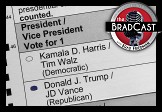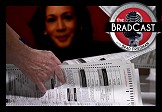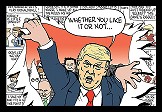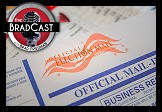Blogged by John Gideon
As reported previously the state of California unfairly treated voters with disabilities in the testing of the Vote-PAD, a voting assistive device designed specifically for use by voters with disabilities and successfully tested and used by those voters across the country. The fact that the staff of the Secretary of State of California used shoddy test procedures and then recommended denial of certification, based on those test procedures, of the Vote-PAD is certainly questionable. Why haven't other voting systems, that purport to be accessible, been tested by the disabilities community at all?
As reported earlier, today is the public hearing for the Vote-PAD. Ellen Theisen, President and Founder of Vote-PAD has testified about the problems with the test procedure. In her testimony she referred to accompanying testimony from Valerie Rice, PhD., CPE, OTR/L, whose PhD is in "Human Factors Engineering (Industrial Engineering and Operations Research) with a specialization in Human Factors Engineering from Virginia Polytechnic Institute and State University, and masters degrees in both Occupational Therapy (University of Puget Sound) and Health Care Administration (Baylor University). She is a Board Certified Professional Ergonomist and a liscensed and registered Occupational Therapist". In other words, Dr. Rice is the person who should have written the states test procedure which would have given everyone a fair and even field for making a judgment on Vote-PAD.
In her testimony Ms. Theisen says:
My primary concern is that the testing procedures failed to simulate a live election, so it’s difficult to know how the results would compare with the results of using the Vote-PAD in a live election. It is clear, however, that in spite of the artificial environment, and with qualitatively more difficult tasks than voters would perform, participants did very well.
On the matter of testing of other voting systems as compared to the Vote-PAD, Ms. Theisen gives a telling example:
♦ It is possible for the eSlate audio to report that one letter was entered when actually another was entered,
♦ There is no way for a blind voter using the eSlate to review the name of a write-in candidate, and
♦ The eSlate’s audio feedback for the Clear/Backup function is confusing.
Since the eSlate can give inaccurate feedback on write-in names, and — unlike the
Vote-PAD — provides no way for voters to verify the name, it appears that voters with visual impairments can cast a write-in vote on the eSlate system even less reliably than on the Vote-PAD. It’s difficult to understand why the staff didn’t consider the eSlate write-in issues enough of a problem to include in their report.
And because the staff chose not to test the eSlate by having voters with visual impairments actually vote on the system – as they did with Vote-PAD – there is no way of knowing how high the write-in error rate would have been, or how reliably blind voters could have cast write-in votes on those systems. And again, because to our knowledge the Secretary of State has no established standard for objectively measuring such reliability, it is difficult to understand what subjective standard was used to reach the staff’s conclusion.
Certainly write-in candidates present a major challenge for voters using the Vote-PAD, but there is no evidence to suggest that the challenge is greater than it is on other systems, since this stringent testing by people with disabilities has not occurred on any other system certified in California.
Dr. Rice summarizes in her testimony:
In her summary, Ms. Theisen says:
California owes it to its disabilities community to conduct appropriate accessibility testing on all systems that it certifies for use by people with disabilities. We urge the Secretary of State to conduct an appropriate test of the Vote-PAD for full certification in the near future, and to include appropriate usability testing in its test protocol template for all systems.
We agree with Ms. Theisen. The state of California, just as with every state in the nation, owes it to voters with disabilities to provide them with a voting system that is accessible for as large a portion of that community as possible. The Vote-PAD does that job but the state has unfairly denied that community their rights.


 How (and Why!) to 'Extend an Olive Branch' to MAGA Family Members Over the Holidays: 'BradCast' 11/21/24
How (and Why!) to 'Extend an Olive Branch' to MAGA Family Members Over the Holidays: 'BradCast' 11/21/24 'Green News Report' 11/21/24
'Green News Report' 11/21/24
 Former Federal Prosecutor: Trump Must Be Sentenced in NY Before Taking Office Again: 'BradCast' 11/20/24
Former Federal Prosecutor: Trump Must Be Sentenced in NY Before Taking Office Again: 'BradCast' 11/20/24 'Bullet Ballot' Claims, Other Arguments for Hand-Counting 2024 Battleground Votes: 'BradCast' 11/19/24
'Bullet Ballot' Claims, Other Arguments for Hand-Counting 2024 Battleground Votes: 'BradCast' 11/19/24 'Green News Report' 11/19/24
'Green News Report' 11/19/24 Trump Already Violating Law (He Signed!) During Transition: 'BradCast' 11/18/24
Trump Already Violating Law (He Signed!) During Transition: 'BradCast' 11/18/24 Sunday 'Into the Gaetz of Hell' Toons
Sunday 'Into the Gaetz of Hell' Toons Computer Security Experts Ask Harris to Seek Hand-Counts Due to Voting System Breaches: 'BradCast' 11/14/24
Computer Security Experts Ask Harris to Seek Hand-Counts Due to Voting System Breaches: 'BradCast' 11/14/24  'Green News Report' 11/14/24
'Green News Report' 11/14/24 Trump Criminal Cases Fade After Election as GOP 'Does Not Believe in Rule of Law': 'BradCast' 11/13/24
Trump Criminal Cases Fade After Election as GOP 'Does Not Believe in Rule of Law': 'BradCast' 11/13/24 Climate Advocates Brace for Fight With Trump 2.0: 'BradCast' 11/12/24
Climate Advocates Brace for Fight With Trump 2.0: 'BradCast' 11/12/24 'Green News Report' 11/12/24
'Green News Report' 11/12/24 Let It All Out: 'BradCast' 11/11/24
Let It All Out: 'BradCast' 11/11/24 Sunday 'Like it or Not' Toons
Sunday 'Like it or Not' Toons Not All Bad: Abortion Rights Won Big (Almost) Everywhere: 'BradCast' 11/7/24
Not All Bad: Abortion Rights Won Big (Almost) Everywhere: 'BradCast' 11/7/24 'Green News Report' 11/7/24
'Green News Report' 11/7/24 U.S. CHOOSES CONVICTED CRIMINAL, ADJUDICATED RAPIST: 'BradCast' 11/6/24
U.S. CHOOSES CONVICTED CRIMINAL, ADJUDICATED RAPIST: 'BradCast' 11/6/24 ELECTION DAY 2024: Tea Leaves, Probs for Voters, What's Next: 'BradCast' 11/5/24
ELECTION DAY 2024: Tea Leaves, Probs for Voters, What's Next: 'BradCast' 11/5/24 'Closing Arguments' for Undecideds, Third-Party Voters: 'BradCast' 11/4/24
'Closing Arguments' for Undecideds, Third-Party Voters: 'BradCast' 11/4/24 The GOP 'Voter Fraud' Before the Storm: 'BradCast' 10/31/24
The GOP 'Voter Fraud' Before the Storm: 'BradCast' 10/31/24 'Closing Arguments'with Digby and Driftglass: 'BradCast' 10/30/24
'Closing Arguments'with Digby and Driftglass: 'BradCast' 10/30/24 Trump Promises to be a Lawless, Authoritarian President. Believe Him: 'BradCast' 10/29/24
Trump Promises to be a Lawless, Authoritarian President. Believe Him: 'BradCast' 10/29/24 Ballots Burn, Billion-aires 'Obey in Advance', Callers Ring In: 'BradCast' 10/28/24
Ballots Burn, Billion-aires 'Obey in Advance', Callers Ring In: 'BradCast' 10/28/24 Musk's Privatized Internet Satellite System Threatens U.S. National Security
Musk's Privatized Internet Satellite System Threatens U.S. National Security
 VA GOP VOTER REG FRAUDSTER OFF HOOK
VA GOP VOTER REG FRAUDSTER OFF HOOK Criminal GOP Voter Registration Fraud Probe Expanding in VA
Criminal GOP Voter Registration Fraud Probe Expanding in VA DOJ PROBE SOUGHT AFTER VA ARREST
DOJ PROBE SOUGHT AFTER VA ARREST Arrest in VA: GOP Voter Reg Scandal Widens
Arrest in VA: GOP Voter Reg Scandal Widens ALL TOGETHER: ROVE, SPROUL, KOCHS, RNC
ALL TOGETHER: ROVE, SPROUL, KOCHS, RNC LATimes: RNC's 'Fired' Sproul Working for Repubs in 'as Many as 30 States'
LATimes: RNC's 'Fired' Sproul Working for Repubs in 'as Many as 30 States' 'Fired' Sproul Group 'Cloned', Still Working for Republicans in At Least 10 States
'Fired' Sproul Group 'Cloned', Still Working for Republicans in At Least 10 States FINALLY: FOX ON GOP REG FRAUD SCANDAL
FINALLY: FOX ON GOP REG FRAUD SCANDAL COLORADO FOLLOWS FLORIDA WITH GOP CRIMINAL INVESTIGATION
COLORADO FOLLOWS FLORIDA WITH GOP CRIMINAL INVESTIGATION CRIMINAL PROBE LAUNCHED INTO GOP VOTER REGISTRATION FRAUD SCANDAL IN FL
CRIMINAL PROBE LAUNCHED INTO GOP VOTER REGISTRATION FRAUD SCANDAL IN FL Brad Breaks PA Photo ID & GOP Registration Fraud Scandal News on Hartmann TV
Brad Breaks PA Photo ID & GOP Registration Fraud Scandal News on Hartmann TV  CAUGHT ON TAPE: COORDINATED NATIONWIDE GOP VOTER REG SCAM
CAUGHT ON TAPE: COORDINATED NATIONWIDE GOP VOTER REG SCAM CRIMINAL ELECTION FRAUD COMPLAINT FILED AGAINST GOP 'FRAUD' FIRM
CRIMINAL ELECTION FRAUD COMPLAINT FILED AGAINST GOP 'FRAUD' FIRM RICK SCOTT GETS ROLLED IN GOP REGISTRATION FRAUD SCANDAL
RICK SCOTT GETS ROLLED IN GOP REGISTRATION FRAUD SCANDAL VIDEO: Brad Breaks GOP Reg Fraud Scandal on Hartmann TV
VIDEO: Brad Breaks GOP Reg Fraud Scandal on Hartmann TV RNC FIRES NATIONAL VOTER REGISTRATION FIRM FOR FRAUD
RNC FIRES NATIONAL VOTER REGISTRATION FIRM FOR FRAUD EXCLUSIVE: Intvw w/ FL Official Who First Discovered GOP Reg Fraud
EXCLUSIVE: Intvw w/ FL Official Who First Discovered GOP Reg Fraud GOP REGISTRATION FRAUD FOUND IN FL
GOP REGISTRATION FRAUD FOUND IN FL


































